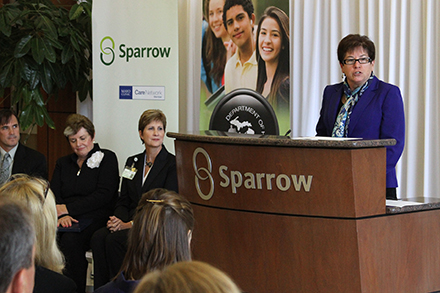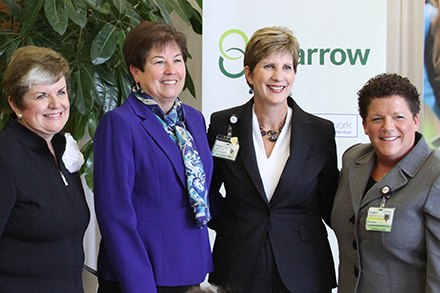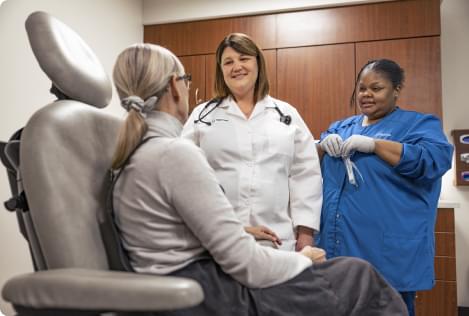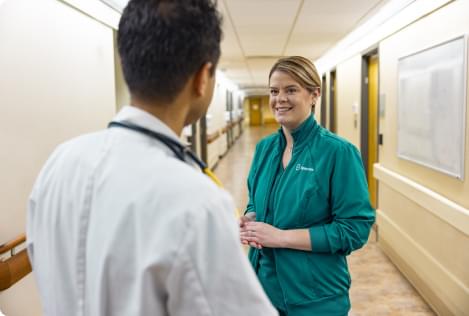

From left: DHS Director Maura Corrigan, Michigan First Lady Sue Snyder, Sparrow Senior Vice President and Chief Nursing Officer Mary Lou Wesley, andKathleen Marble, Director of Sparrow Women and Children’s Services.
Published: Sept. 18, 2014
Michigan First Lady Sue Snyder today praised collaborative efforts between Sparrow Hospital and the Michigan Departments of Human Services (DHS) and Community Health (MDCH) to raise awareness among new parents about the dangers of unsafe sleep practices. The collaboration goes beyond requirements of the new Michigan Infant Safe Sleep Act signed into law by Gov. Rick Snyder in May.
The safe sleep partnership was announced today at Sparrow Hospital in Lansing. About 140 Michigan babies die annually due to unsafe sleep environments. Health providers have emphasized these deaths are 100 percent preventable.
The new state law requires hospitals and health professionals to provide parents readily available information and educational materials such as a brochure or educational video regarding infant safe sleep practices following the birth of a child. Sparrow wants to do even more than the law requires. Sparrow staff members model proper safe sleep practices for parents of newborns at the hospital when they place babies in cribs. Staff members verbally express how they’re laying babies down in a safe sleep environment, such as by saying, “We’re making sure the head of the bed is flat.”
“I am sure all mothers across Michigan can agree that it is hard to imagine anything as devastating as the loss of a child, especially a loss that is preventable,” Snyder said. “Sparrow Hospital has long been a local leader in safe sleep education. I’m thankful for the work they have done and continue to do to help ensure no little ones are lost too soon.”
Unsafe sleep infant deaths are due to suffocation as a result of unsafe sleep environments. To keep babies safe, parents and caregivers must:
- Never put the baby to sleep with adults or other children, as this practice exponentially increases the chance of a tragedy.
- Put babies in cribs of their own – never on adult beds, pillows or couches.
- Ensure that the crib does not contain extraneous items, including pillows, crib bumpers and stuffed animals, and use a safe sleep sack instead of blankets.
- Place the baby to sleep on his/her back, not on the stomach or side.
- Not overheat the baby.
- Make certain that no one smokes around the baby.
“Infant death due to unsafe sleep is 100 percent preventable and it starts here, at the hospital, from day one,” said Kathleen Marble, director of Sparrow Women and Children’s Services.
“Prevention is more than just telling parents the “don’ts” and handing them a brochure. It means modeling the proper practices while they are here, educating them on the why behind the “don’ts” and setting the family up so it feels natural to continue safe sleep practices at home.”
In addition to Marble, the first lady was joined today by DHS Director Maura Corrigan, MDCH Director Nick Lyon and Sparrow Senior Vice President and Chief Nursing Officer Mary Lou Wesley.
“Together with our partners at the Department of Community Health and health care organizations like Sparrow, our mission at DHS is to educate parents and caregivers about safe sleep,” Corrigan said. “No family should have to mourn a child due to not understanding the tragic consequences of co-sleeping, or that a baby crib or pack and play is the only safe place for an infant to sleep.”
Lyon added: “Every three days in Michigan a baby dies because he or she was put to sleep in an unsafe sleep environment. Together, we can end these entirely preventable deaths. Efforts that go above and beyond such as those by Sparrow and our other healthcare partners across the state are a tremendous step in the right direction toward making sure our parents and caregivers have the information they need and saving lives.”
A video about infant safe sleep is available on Michigan’s Safe Sleep website, www.michigan.gov/safesleep. Information about safe sleep is also available at local health departments and DHS offices.


